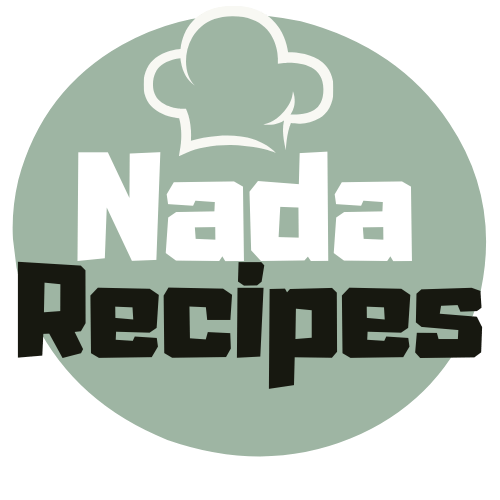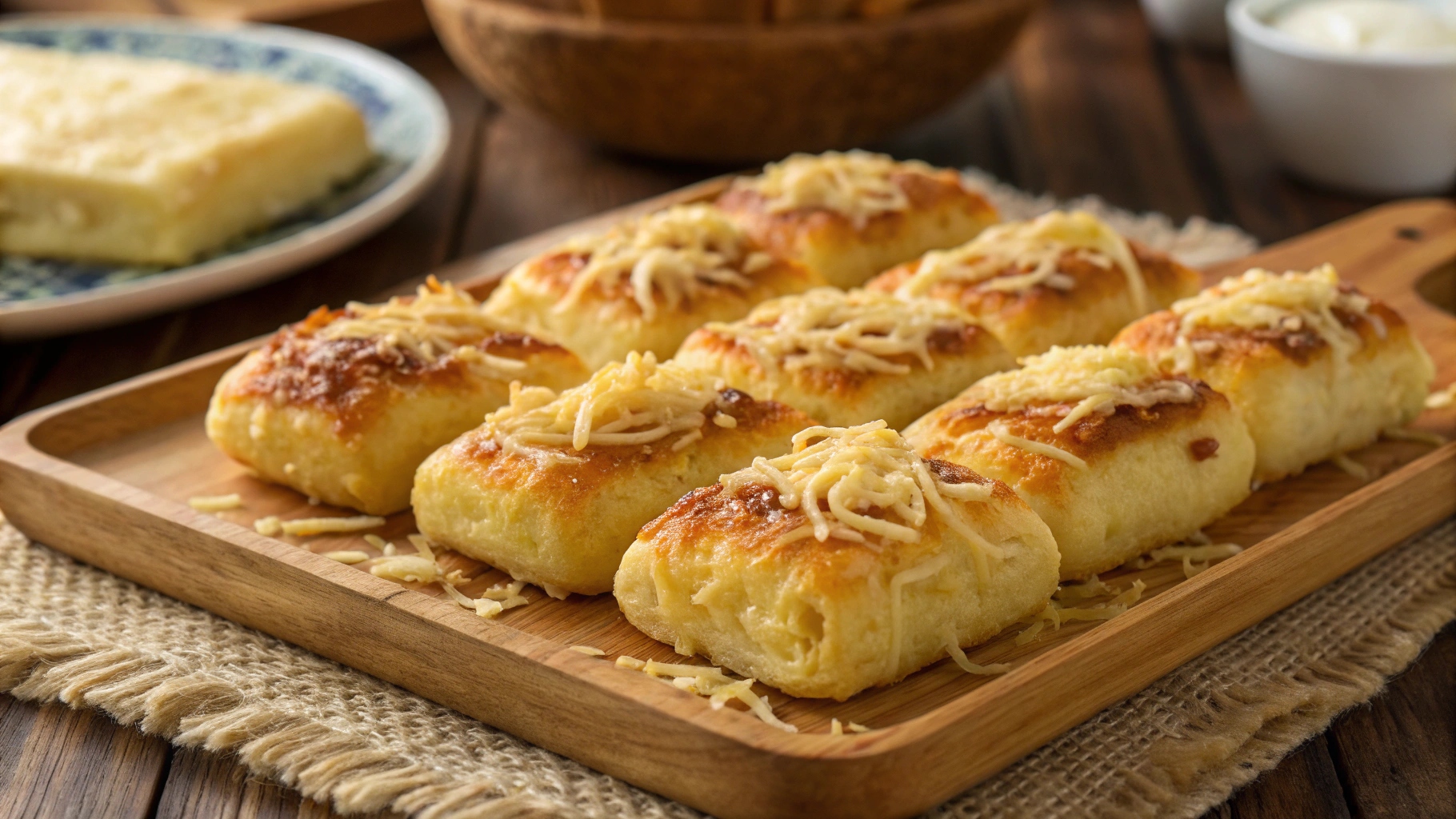Introduction
Kue Kastengel, also known as Dutch-Indonesian cheese tarts, is a beloved savory snack in Indonesia, especially during festive seasons like Eid and Christmas. These small, rectangular cheese pastries have a rich, buttery taste with a crisp, crumbly texture. Unlike sweet cookies, Kastengel is made with sharp cheeses such as Edam, Gouda, or Cheddar, giving them a deliciously salty and umami flavor.
With roots in Dutch cuisine, Kastengel has become a staple in Indonesian households, enjoyed with tea or coffee. In this article, we will explore its history, key ingredients, step-by-step recipes, storage tips, and frequently asked questions to help you master the art of making this delicious snack at home.
Part 1: The History and Origins of Kue Kastengel
1.1 Dutch Influence on Indonesian Cuisine
Kue Kastengel has its roots in the Dutch colonial era when European baking techniques were introduced to Indonesia. The name itself comes from the Dutch words kaas (cheese) and stengel (stick), originally referring to cheese breadsticks popular in the Netherlands. Over time, Indonesians adapted the recipe using local ingredients, making it a staple festive snack.
1.2 Evolution of Kastengel in Indonesia
While Dutch cheese biscuits were typically long and crispy, the Indonesian version became shorter and richer due to the addition of butter and egg yolks. Instead of using traditional Dutch cheeses like Edam or Gouda exclusively, many modern variations incorporate local Cheddar, making it more accessible.
1.3 When is Kastengel Traditionally Made?
Kastengel is commonly baked during:
- Eid al-Fitr (Lebaran) – Served alongside sweet cookies like Nastar (pineapple tarts).
- Christmas & New Year – A must-have treat in many Indonesian families.
- Other Special Occasions – Such as weddings, birthdays, or as gifts.
Kastengel remains a symbol of festive joy, representing the fusion of Dutch heritage and Indonesian flavors.
Part 2: Key Ingredients for Kastengel

Kue Kastengel (Dutch-Indonesian Cheese Tarts)
Ingredients
- 100 g butter
- 2 egg yolks
- 200 g all-purpose flour
- 20 g cornstarch
- 1/2 teaspoon baking powder
- 100 g grated cheese (Edam, Gouda, or Cheddar)
- Egg yolk for brushing
- Extra grated cheese for topping
Instructions
- Mix butter and egg yolks until smooth
- Gradually add flour, cornstarch, and baking powder
- Fold in grated cheese and knead into a dough
- Roll out the dough, cut into small rectangles, and place on a baking sheet
- Brush with egg yolk, sprinkle cheese, and bake at 320°F (160°C) for 20-25 minutes.
Notes
✅ Use Aged Cheese for Maximum Flavor – Edam, Gouda, or Cheddar work best. The sharper the cheese, the more intense the flavor. ✅ Chill the Dough Before Baking – Refrigerating the dough for at least 30 minutes helps firm it up, making it easier to shape and resulting in crispier cookies. ✅ Don’t Overmix the Dough – Over-kneading will develop gluten, making the Kastengel tough instead of crumbly. Mix just until the dough comes together.
Part 3: Step-by-Step Kastengel Recipe
3.1 Preparing the Dough
Follow these steps to make the perfect Kastengel dough:
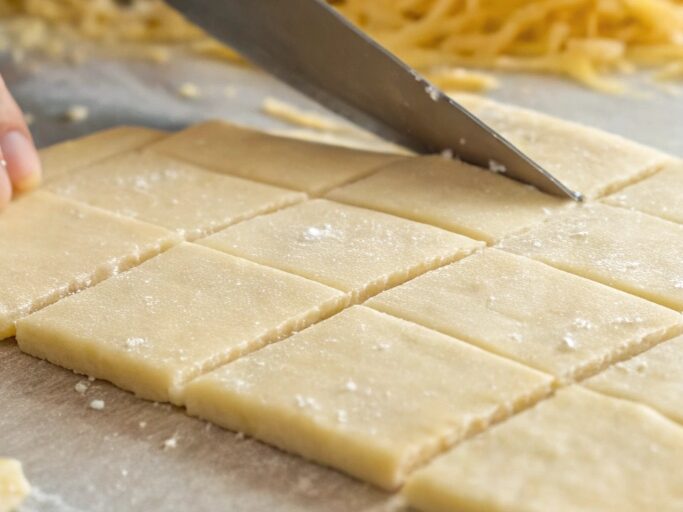
- Grate the cheese – Use a fine grater to ensure even mixing. Set aside.
- Mix butter and egg yolks – In a bowl, beat 100g of butter and 2 egg yolks until smooth and creamy.
- Add dry ingredients – Gradually sift and mix in:
- 200g all-purpose flour
- 20g cornstarch
- ½ teaspoon baking powder
- Incorporate the cheese – Gently fold in 100g of grated cheese and mix until the dough forms a smooth ball.
- Rest the dough – Wrap in plastic and chill for 30 minutes to firm up.
3.2 Shaping and Baking the Kastengel
- Preheat the oven to 320°F (160°C) and line a baking sheet with parchment paper.
- Roll out the dough to about 1 cm thick on a lightly floured surface.
- Cut into small rectangles (about 3 cm long and 1 cm wide).
- Place on a baking tray, leaving a small space between each piece.
- Brush with egg yolk for a golden finish.
- Sprinkle extra cheese on top for a richer flavor.
- Bake for 20-25 minutes until golden brown and crisp.
3.3 Cooling and Storing the Kastengel
- Let the Kastengel cool completely on a wire rack before storing.
- Store in an airtight container to maintain crispness for up to 3 weeks.
- If needed, refrigerate or freeze for longer storage (see Part 6 for details).
Now, you have a batch of delicious, crunchy, and cheesy Kastengel ready to enjoy!
Part 4: Tips for the Best Kue Kastengel
To achieve the perfect Kastengel—crispy, cheesy, and full of flavor—follow these expert tips:
4.1 Choosing the Best Cheese
- Use aged cheese – The older the cheese, the sharper the flavor. Aged Edam or Cheddar works best.
- Grate finely – This helps the cheese mix evenly into the dough for a uniform taste.
- Don’t substitute with processed cheese – It has more moisture and can make the dough too soft.
4.2 Perfecting the Dough
- Don’t overmix – Over-kneading will develop too much gluten, making the cookies tough.
- Chill the dough – Letting it rest in the fridge for at least 30 minutes helps firm it up, making it easier to shape.
- Adjust flour as needed – If the dough is too sticky, add a little more flour, but not too much, or the cookies will be dry.
4.3 Baking for the Perfect Texture
- Use low heat (320°F/160°C) – High temperatures can burn the cheese before the cookies are fully baked.
- Evenly space the cookies – This allows proper air circulation for even baking.
- Check the bottom color – The cookies should be golden brown on the bottom and slightly darker on top.
4.4 Enhancing the Flavor
- Brush with egg yolk – This gives the cookies a shiny, golden surface.
- Add a pinch of nutmeg or white pepper – This enhances the cheesy flavor with a subtle kick.
- Use unsalted butter – This allows better control over the salt level, as cheese is already salty.
By following these tips, your Kastengel will turn out flavorful, crispy, and irresistibly cheesy every time!
Part 5: Variations of Kue Kastengel
While the classic Kastengel is made with cheese, there are several exciting variations you can try to suit different tastes and preferences.
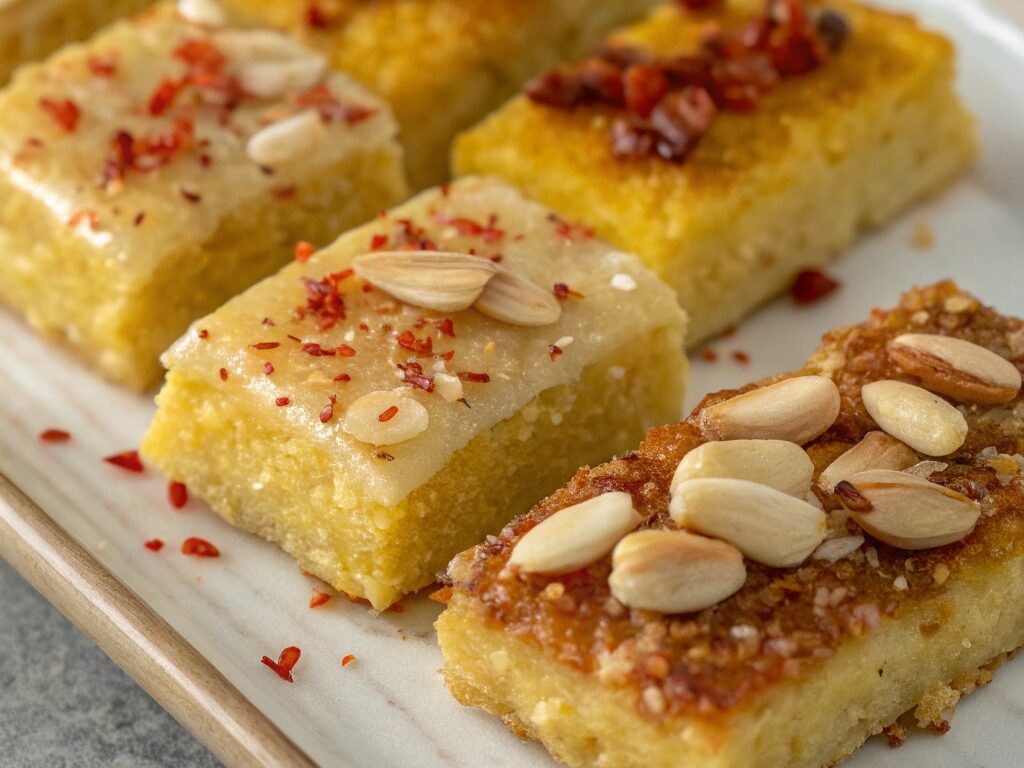
5.1 Spicy Kue Kastengel
For those who love a little heat, add:
- ½ teaspoon chili powder or paprika to the dough.
- Finely chopped red chili for extra spiciness.
- A pinch of cayenne pepper to balance the cheese flavor.
This variation adds a slight kick, making the cheese sticks even more flavorful.
5.2 Nutty Kue Kastengel
Enhance the texture and taste by adding:
- Crushed almonds or cashews into the dough for a crunchy bite.
- Sesame seeds sprinkled on top before baking.
- Pine nuts or walnuts for a richer, nutty flavor.
The combination of cheese and nuts creates a delicious contrast in flavor and texture.
5.3 Garlic Butter Kastengel
For a more aromatic twist:
- Add 1 teaspoon garlic powder to the dough.
- Brush the cookies with garlic-infused butter before baking.
- Sprinkle with dried parsley for extra fragrance.
This variation gives the cheese tarts a deep umami flavor, perfect for garlic lovers.
5.4 Healthier Whole Wheat Kastengel
For a more nutritious option:
- Substitute half of the all-purpose flour with whole wheat flour.
- Use less butter and replace some with Greek yogurt.
- Reduce salt and opt for a milder cheese like mozzarella.
This version retains the crunch but with added fiber and a slightly nutty taste.
5.5 Sweet and Savory Kastengel
If you enjoy a balance of flavors:
- Add a teaspoon of honey or maple syrup to the dough.
- Use a mix of salty and mild cheese for contrast.
- Sprinkle with a touch of brown sugar for a caramelized effect.
This variation creates an interesting blend of salty, sweet, and buttery flavors.
By experimenting with these variations, you can customize Kastengel to match your personal taste or surprise guests with new flavors!
Part 6: How to Store Kastengel Properly
To keep Kastengel fresh, crispy, and full of flavor, proper storage is essential. Whether you plan to enjoy them within a few weeks or store them for months, follow these guidelines to maintain their quality.
6.1 Storing Kastengel at Room Temperature
- Place the fully cooled Kastengel in an airtight container to prevent moisture from softening them.
- Store at room temperature (below 77°F/25°C) in a dry place, away from direct sunlight.
- Use silica gel packets inside the container to absorb excess moisture.
- Properly stored, Kastengel can stay fresh and crisp for up to 3 weeks.
6.2 Refrigerating Kastengel for Longer Shelf Life
If you want to store Kastengel for more than a few weeks:
- Keep them in an airtight container or ziplock bag to prevent them from absorbing fridge odors.
- Store in the refrigerator at 35-40°F (2-4°C).
- Before serving, let them return to room temperature or reheat in an oven at 300°F (150°C) for 5 minutes to restore crispiness.
- Refrigerated Kastengel can last 1-2 months without losing too much texture.
6.3 Freezing Kastengel for Long-Term Storage
For storage beyond two months, freezing is the best option:
- Place Kastengel in a sealed, freezer-safe container or bag.
- Freeze at 0°F (-18°C) or lower.
- When ready to eat, thaw at room temperature for 30 minutes or bake at 300°F (150°C) for 5-7 minutes to regain crispiness.
- Frozen Kastengel can last up to 3 months without significant quality loss.
6.4 Preventing Sogginess and Maintaining Freshness
- Never store warm or freshly baked Kastengel in a container—it will trap moisture and make them soft.
- Avoid exposure to air for extended periods, as it can make them stale.
- If they become slightly soft, toast them in the oven for 3-5 minutes to restore crunch.
By following these storage tips, you can enjoy Kastengel fresh and crispy anytime, whether you eat them within a few days or save them for later.
Part 7: Serving Suggestions and Pairings
Kastengel is a versatile snack that can be enjoyed on its own or paired with various drinks and dishes. Here are some serving ideas to elevate your cheese tart experience.
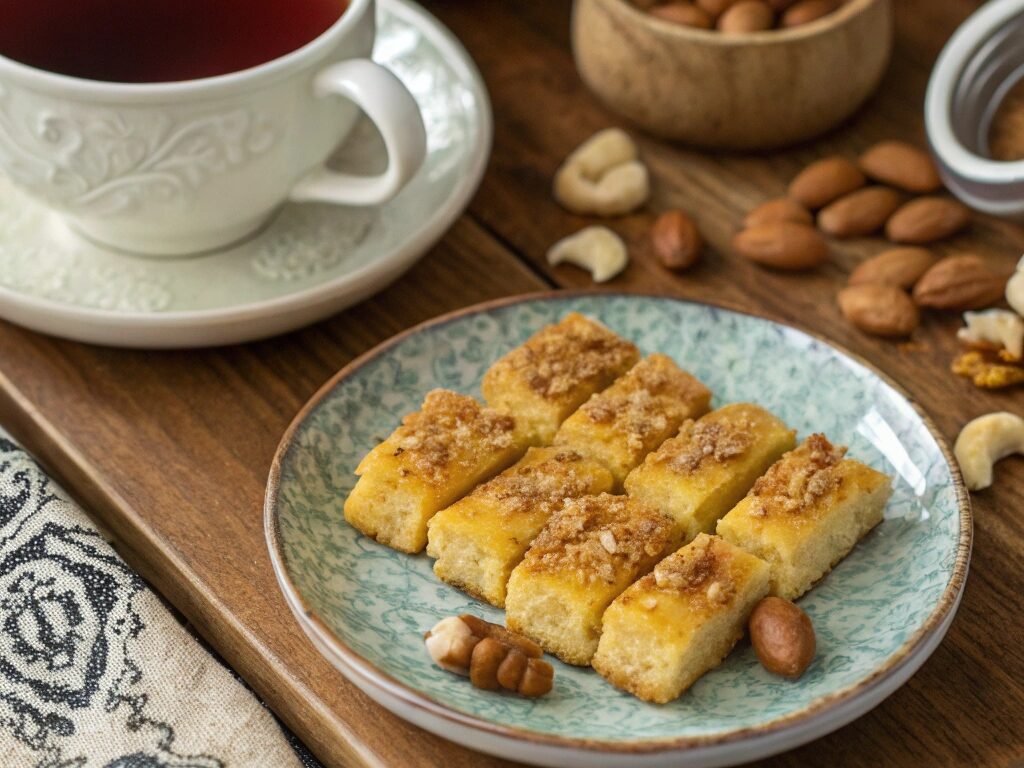
7.1 Best Drinks to Pair with Kastengel
Since Kastengel has a rich, cheesy, and slightly salty taste, it pairs well with beverages that balance its flavors.
- Tea – A warm cup of black tea or green tea complements the buttery and savory taste.
- Coffee – A strong espresso or cappuccino enhances the richness of Kastengel.
- Hot Chocolate – A sweet and creamy hot chocolate provides a nice contrast to the salty cheese.
- Milk – Cold or warm milk makes a great companion, especially for kids.
- Wine – A glass of white wine (like Chardonnay) or a light red wine (like Pinot Noir) pairs beautifully with the cheesy notes.
7.2 Perfect Occasions to Serve Kastengel
Kastengel is commonly served during special celebrations, but it’s also perfect for everyday snacking.
- Eid al-Fitr (Lebaran) – A staple treat during family gatherings.
- Christmas & New Year – Enjoyed alongside other holiday cookies and cakes.
- Afternoon Tea Time – A great addition to tea parties or casual get-togethers.
- Snack for Work or School – Pack a small container of Kastengel for a quick, satisfying bite.
- Party Appetizers – Arrange Kastengel on a cheese platter with nuts, fruits, and cold cuts.
7.3 Kastengel as a Gourmet Snack
Take your Kastengel to the next level by serving it with dips or toppings:
- Honey or Fig Jam – A sweet touch to balance the saltiness.
- Cream Cheese or Butter – Adds extra richness.
- Olives and Sun-Dried Tomatoes – A Mediterranean-inspired pairing.
7.4 Kastengel in Gift Hampers
Because of its long shelf life, Kastengel makes a perfect homemade gift. Pack them in a beautiful tin box or decorative jar, and pair them with coffee or tea for a thoughtful present during holidays.
By experimenting with different pairings and serving styles, you can enjoy Kastengel in many creative and delicious ways!
Part 8: Frequently Asked Questions (FAQs)
Here are answers to some of the most common questions about Kastengel.
8.1 What is a Kastengel in English?
Kastengel translates to cheese sticks or cheese tarts in English. The name comes from Dutch, where kaas means cheese and stengel means stick. It refers to the small, rectangular, savory cheese pastries popular in Indonesia.
8.2 Do you need to refrigerate cheese tarts?
No, Kastengel does not need to be refrigerated if stored properly in an airtight container at room temperature. However, if you want to keep them fresh for more than three weeks, refrigeration or freezing is recommended.
8.3 Can I use different types of cheese for Kastengel?
Yes! While traditional recipes use Edam, Gouda, or Cheddar, you can experiment with Parmesan, Mozzarella, or Gruyère for different flavors. Aged cheeses work best because they provide a sharper taste and crispier texture.
8.4 Why is my Kastengel not crispy?
The dough was too wet (too much butter or cheese).
The oven temperature was too low, causing the cookies to bake slowly and absorb moisture.
They were not cooled completely before being stored, trapping steam inside the container.
They were not baked long enough—extend baking time by 3-5 minutes if needed.
To fix soft Kastengel, toast them in the oven at 300°F (150°C) for 5 minutes to restore crispiness.
8.5 Can I make Kastengel without an oven?
Yes! If you don’t have an oven, you can try these alternative methods:
Air Fryer – Bake at 300°F (150°C) for 12-15 minutes until golden brown.
Stovetop Baking – Place in a covered non-stick pan over low heat for 15-20 minutes, flipping halfway through.
Toaster Oven – Bake at 320°F (160°C) for 15-20 minutes, checking frequently to avoid burning.
Part 9: Conclusion
Kue Kastengel, the beloved Dutch-Indonesian cheese tart, is a must-have snack during festive celebrations and family gatherings. Its rich, buttery, and cheesy flavor makes it a favorite among both adults and children. With its crunchy texture and savory taste, Kastengel stands out as a delicious alternative to traditional sweet cookies.
By following the step-by-step recipe, using high-quality cheese, and applying the right baking techniques, you can create the perfect batch of Kastengel at home. Whether you enjoy it with a cup of tea, serve it as a party snack, or give it as a homemade gift, this cheesy treat is always a delight.
With various storage options, you can keep Kastengel fresh and crispy for weeks, ensuring that you always have a tasty bite ready whenever you crave one. Plus, with creative variations like spicy, nutty, or garlic-infused Kastengel, you can customize the recipe to suit your taste preferences.
Now that you have all the knowledge to make and store Kastengel properly, it’s time to try baking them yourself! Enjoy the rich flavors of this classic cheese tart and share it with your loved ones.
Happy baking!
Kue Kastengel
